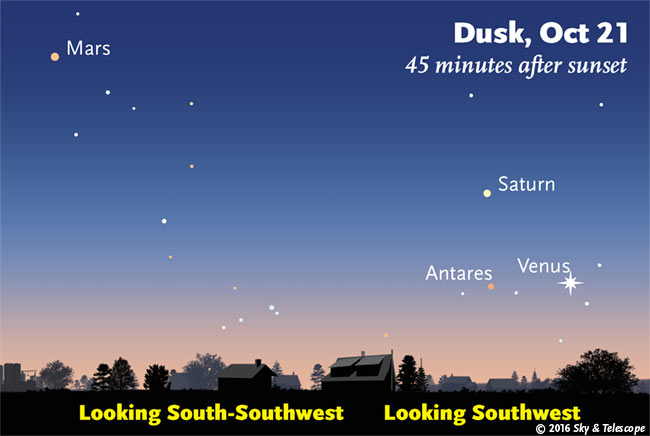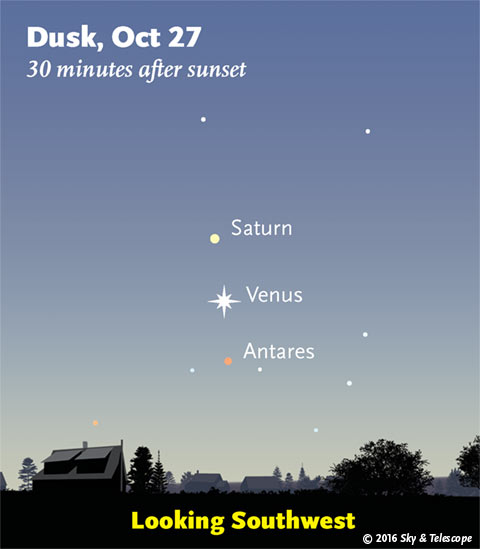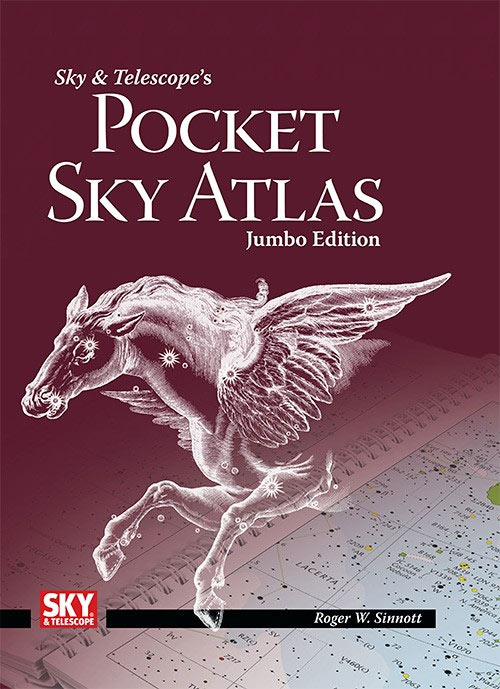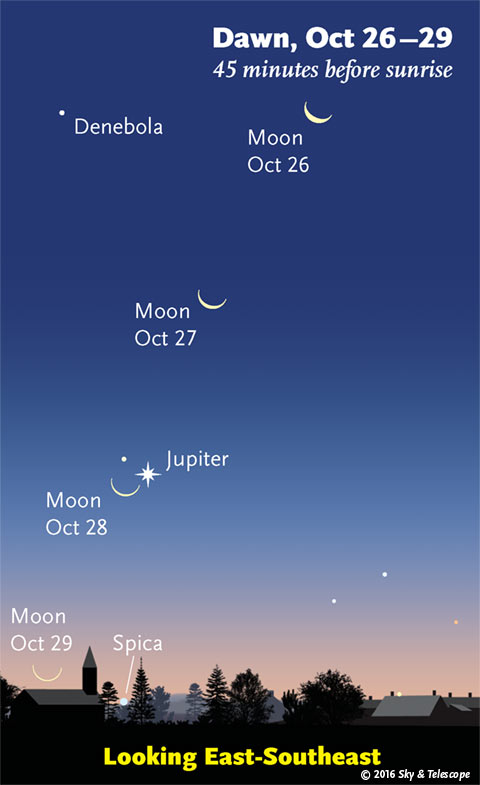Astronomy - This Week’s Sky at a Glance, October 21 – 29

A planet-laden panorama.
Friday, October 21
• Saturn and Antares form a compact right triangle with bright Venus, low in the southwest at dusk as shown above. The triangle will narrow every day as Venus moves toward the upper left.
• The modest Orionid meteor shower should continue before dawn Saturday, but the light of the last-quarter Moon interferes.
Saturday, October 22
• Capella sparkles low in the northeast these evenings. Look for the Pleiades cluster off to its right, by about three fists at arm's length. These two heralds of the cold months ahead rise higher as the night grows later. . . and colder.
• Upper right of Capella, and upper left of the Pleiades, stars of Perseus highlight the winter Milky Way.
Sunday, October 23
• This is the time of year when the Big Dipper lies horizontal low in the north-northwest early in the evening. How low? The farther south you are, the lower. Seen from 40° north latitude (New York, Denver) its bottom stars twinkle nearly ten degrees high. But at Miami (26° N) the entire Dipper skims along out of sight below the north horizon.
Monday, October 24
• Vega is the brightest star high in the west these evenings. Less high in the southwest is Altair, not quite as bright. Just upper right of Altair, by a finger-width at arm's length, is distant orange Tarazed. Straight down from Tarazed runs the stick-figure backbone of the constellation Aquila, the Eagle.
• In early dawn tomorrow morning the 25th, you'll find Regulus, the forefoot of Leo, under the waning crescent Moon. Look very far to their lower left for Jupiter. Look even farther to their lower right for Sirius, in the south-southwest.
Tuesday, October 25
• Draw a line from Altair, the brightest star high in the southwest after dark, to Vega, the brightest high in the west. Continue the line half as far onward and you hit the Lozenge: the pointy-nosed head of Draco, the Dragon.
• The Great Square of Pegasus is now quite high in the east-southeast just after dark — still, for now, balancing on one corner (as seen from the world's mid-northern latitudes).
Wednesday, October 26
• Low in the southwest in twilight, Saturn, bright Venus, and Antares form a nearly vertical curve, in that order from top to bottom. It's 7° tall.

Venus passes between Saturn and Antares low in twilight on Thursday the 27th. (The visibility of faint stars in bright twilight is exaggerated here.)
Thursday, October 27
• Now Saturn, bright Venus, and Antares straighten out into a nearly vertical line, as shown at right.
Friday, October 28
• The low twilight lineup of Saturn, Venus, and Antares in the southwest now begins to bend the other way, as Venus moves east.
• Around the same time, look for Arcturus low in the west-northwest.
Saturday, October 29
• The Ghost of Summer Suns. Halloween is approaching, and this means that Arcturus, the star sparkling low in the west-northwest in twilight, is taking on its role as "the Ghost of Summer Suns." For several days centered on October 29th every year, Arcturus occupies a special place above your local landscape. It closely marks the spotwhere the Sun stood at the same time, by the clock, during hot June and July — in broad daylight, of course.
So, in the last days of October each year, you can think of Arcturus as the chilly Halloween ghost of the departed summer Sun.
_________________________
Want to become a better astronomer? Learn your way around the constellations! They're the key to locating everything fainter and deeper to hunt with binoculars or a telescope.
This is an outdoor nature hobby. For an easy-to-use constellation guide covering the whole evening sky, use the big monthly map in the center of each issue of Sky & Telescope, the essential guide to astronomy.

The Pocket Sky Atlas plots 30,796 stars to magnitude 7.6 — which may sound like a lot, but it's less than one per square degree on the sky. Also plotted are many hundreds of telescopic galaxies, star clusters, and nebulae. Shown above is the new Jumbo Edition for easier reading in the night. Click image for larger view.
Once you get a telescope, to put it to good use you'll need a detailed, large-scale sky atlas (set of charts). The basic standard is the Pocket Sky Atlas (in either the original or new Jumbo Edition), which shows stars to magnitude 7.6.
Next up is the larger and deeper Sky Atlas 2000.0, plotting stars to magnitude 8.5, nearly three times as many. The next up, once you know your way around, is the even larger Uranometria 2000.0 (stars to magnitude 9.75). And read how to use sky charts with a telescope.
You'll also want a good deep-sky guidebook, such as Sue French's Deep-Sky Wonders collection (which includes its own charts), Sky Atlas 2000.0 Companion by Strong and Sinnott, or the bigger Night Sky Observer's Guide by Kepple and Sanner.
Can a computerized telescope replace charts? Not for beginners, I don't think, and not on mounts and tripods that are less than top-quality mechanically (meaning heavy and expensive). And as Terence Dickinson and Alan Dyer say in their Backyard Astronomer's Guide, "A full appreciation of the universe cannot come without developing the skills to find things in the sky and understanding how the sky works. This knowledge comes only by spending time under the stars with star maps in hand."
This Week's Planet Roundup

The waning crescent Moon passes Jupiter low in the dawn of Saturday the 28th. That star near them is 3rd-magnitude Gamma Virginis (Porrima). As always, the Moon's placement is exact for a viewer at latitude 40° north, longitude 90° west.
Mercury is hidden in the glare of the Sun.
Venus (magnitude –4.0) shines low in the southwest during evening twilight.
Mars (magnitude +0.3) still glows in the south-southwest at dusk, some 40° upper left of Venus. In a telescope, Mars has shrunk to 8 arcseconds in diameter.
Jupiter (magnitude –1.7) is low in the east in early dawn. Binoculars will help show Gamma Virginis about 2° left of it, if you look before the sky grows too bright.
Saturn (magnitude +0.5) glimmers low in the southwest near Venus as twilight fades. It's 10° upper left of Venus on October 21st, and 4° above it on the 28th. Look for Antares (magnitude +1.0) twinkling 7° below Saturn all week.
Uranus (magnitude 5.7, in Pisces) and Neptune(magnitude 7.8, in Aquarius) are well up after dark in the east and southeast, respectively. Info and finder charts.
__________________________
All descriptions that relate to your horizon — including the words up, down, right, and left — are written for the world's mid-northern latitudes. Descriptions that also depend on longitude (mainly Moon positions) are for North America.
Eastern Daylight Time (EDT) is Universal Time (UT, UTC, or GMT) minus 4 hours.
__________________________
"This adventure is made possible by generations of searchers strictly adhering to a simple set of rules. Test ideas by experiments and observations. Build on those ideas that pass the test. Reject the ones that fail. Follow the evidence wherever it leads, and question everything. Accept these terms, and the cosmos is yours."
— Neil deGrasse Tyson
— Neil deGrasse Tyson
No comments:
Post a Comment